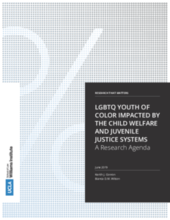Lesbian, gay, bisexual, transgender, and queer (LGBTQ) youth of color (YOC) are overrepresented in two major systems that represent government and community response to crises—child welfare and juvenile justice (Huggins-Hoyt, Briggs, Mowbray, & Allen, 2019; Irvine, Angela & Canfield, 2016; Wilson et al., 2017; Wilson & Kastanis, 2015). Moreover, sexual minority girls of color are especially overrepresented in both systems. Using an intersectionality lens (Bowleg, 2008; Crenshaw, 1991; Wilson & Harper, 2012) and a critical public health approach (Bunton & Wills, 2004), we would expect that system-involved youth who are both LGBTQ and a racial or ethnic minority would experience both similar and unique structural factors leading to differential rates of involvement with and emancipation from these systems compared to other youth. We have attempted to consider multiple forms of inequality and structural drivers in both the convening that led to the development of this report, as well as in the report itself.
This report is a collection of working papers focused on understanding what we know and what we need to better understand about the lives and outcomes of system-involved youth who are both LGBTQ and racial/ethnic minorities. The working papers evolved out of The Intersectional Convening on LGBTQ Youth of Color in Child Welfare and Juvenile Justice Systems held at UCLA School of Law to identify gaps in knowledge related to LGBTQ youth of color in the child welfare and juvenile justice systems and to recommend areas of future research. The convening of senior and rising scholars was organized by the Williams Institute, and supported by the Annie E. Casey Foundation and the Palette Fund, to develop a research-based and data-driven blueprint for action by scholars who are primarily LGBTQ and/or people of color themselves. As part of the blueprint setting process, a secondary aim was to form a community of scholars who would collaborate on research to reduce contact with the child welfare and juvenile justice systems and to promote positive outcomes (e.g., permanency, employment, mental well-being) among those who are system-involved. Additionally, once the working papers were completed, the editors of the working paper collection worked with LGBTQ youth of color so that they could share their feedback on the report findings and recommendations, which we then incorporated.

